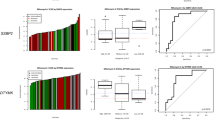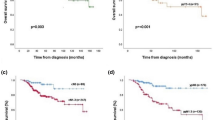Abstract
In the present study, we determined the frequency and intensity of MRP protein expression by monoclonal antibody immunohistochemistry in a series of 259 resected invasive primary breast carcinomas, and we evaluated MRP immunoreactivity in relation to patient and tumour characteristics, relapse-free (RFS) and overall survival (OS). The immunostaining was graded on a semiquantitative scale that ranged from (-) to ( ). Overall, 34% of the tumours were positive for anti-MRP antibody: 19% showed weak cytoplasmic staining (+), 14% had clear cytoplasmic staining (++) and only 1% of the tumours had a strong cytoplasmic as well as membranous staining ( ). MRP expression was not related to patient's age, menopausal status, tumour size, differentiation grade, oestrogen and progesterone receptor level or lymph node involvement. In an exploratory univariate analysis of all patients, only primary tumour size and number of lymph nodes involved were significantly associated with shortened RFS (P < 0.001 and P < 0.001 respectively) and OS (P = 0.02 and P < 0.001 respectively). In Cox univariate analysis for RFS in subgroups of patients stratified by menopausal status, tumour size, nodal status, adjuvant systemic therapy and oestrogen and progesterone receptor status, MRP expression was associated with increased risk for failure in patients with small tumours (T1), in node-negative patients and in node-positive patients who received adjuvant systemic chemotherapy with cyclophosphamide, methotrexate and 5-fluorouracil (CMF); the relative hazard rate (RHR) for relapse was increased in the presence of MRP, with RHR values with 95% confidence limits (CL) of 2.8 (1.2-6.9), 2.1 (1.0-4.2) and 2.8 (0.8-9.9) respectively. In analysis for OS, expression of MRP was also associated with increased risk for failure in patients with small tumours (T1) [RHR (95% CL) 2.3 (0.9-6.0)] and in node-positive patients who received adjuvant systemic chemotherapy with CMF [RHR (95% CL) 3.7 (0.8-17.1)] but not in node-negative patients [RHR (95% CL) 1.1 (0.4-2.6)]. In conclusion, our results show that MRP is frequently overexpressed in primary breast cancer and suggest that MRP expression might be of prognostic significance in the subgroups of patients with the more favourable prognosis, i.e. patients with small tumours and node-negative patients, as well as in the setting of adjuvant systemic chemotherapy. In primary breast cancer, MRP might be related to altered cell biological behaviour, including a more aggressive phenotype, and resistance to adjuvant systemic chemotherapy.
This is a preview of subscription content, access via your institution
Access options
Subscribe to this journal
Receive 24 print issues and online access
$259.00 per year
only $10.79 per issue
Buy this article
- Purchase on Springer Link
- Instant access to full article PDF
Prices may be subject to local taxes which are calculated during checkout
Similar content being viewed by others
Author information
Authors and Affiliations
Rights and permissions
About this article
Cite this article
Nooter, K., Brutel de la Riviere, G., Look, M. et al. The prognostic significance of expression of the multidrug resistance-associated protein (MRP) in primary breast cancer. Br J Cancer 76, 486–493 (1997). https://doi.org/10.1038/bjc.1997.414
Issue Date:
DOI: https://doi.org/10.1038/bjc.1997.414
This article is cited by
-
Chemotherapy induces Notch1-dependent MRP1 up-regulation, inhibition of which sensitizes breast cancer cells to chemotherapy
BMC Cancer (2015)
-
The molecular mechanisms underlying the therapeutic resistance of cancer stem cells
Archives of Pharmacal Research (2015)
-
Cancer drug resistance: an evolving paradigm
Nature Reviews Cancer (2013)
-
A molecular understanding of ATP-dependent solute transport by multidrug resistance-associated protein MRP1
Cancer and Metastasis Reviews (2007)
-
Portrait of multifaceted transporter, the multidrug resistance-associated protein 1 (MRP1/ABCC1)
Pflügers Archiv - European Journal of Physiology (2007)



